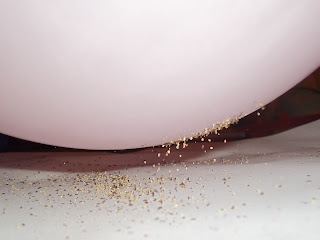Friday, February 24, 2012
Anti-gravity pepper
I didn't expect this to be such a cool effect. We put some pepper on a sheet of paper and then built up an electrostatic charge on a balloon by rubbing it against our hair (Jr. scientist A thought that was pretty funny). As we brought the balloon close to the pepper, the pepper became positively charged and started flying up off the paper and onto the balloon. As we held the balloon in place, more pepper kept flying up (and down) for a few seconds. It was so neat we kept repeating the experiment, trying to build up an electrostatic charge in different objects like plastic spoons (worked well) and cups (not so well). Jr scientist A and the senior lab members watched in amazement.
Tuesday, February 21, 2012
Parachutes
We decided to try our hand at making parachutes. Once again our brave gingerbread men rose to the occasion. Our first attempt used a coffee filter (nicely hyperbolic), and resulted in a slightly slowed descent. Jr scientist A came up with his own design (on the right), which worked better than mine (what does it say when a 4 year old can design a better parachute than you!). Jr scientist A wanted us to make parachutes for him and his sister, but I think such an endeavor might be a little premature.
Sunday, February 19, 2012
Hidden bubbles
We found this effect quite by accident. One of Jr. scientist A's new favorite things to do is to mix various ingredients together to see what happens - I think we have a budding chemist! We were adding things to red cabbage-dyed water (a pH indicator). As expected, when we added baking soda, the mixture turned blue, and adding vinegar to the same mixture caused it to bubble and then turn red. What caught us by surprise was that we next added salt and the mixture bubbled again. I had never heard of salt causing a chemical reaction resulting in bubbles, so we did some more investigating. Adding more salt turned the mixture from red (acidic) to purple, as would happen when you added a base, making us think that salt was a base (it's actually neutral). We tried combining vinegar and salt in another cup and got a rather unexciting cup of salty vinegar with no bubbles. After some google-ing, we found out that the salt wasn't actually creating bubbles, it was releasing the carbon dioxide bubbles trapped in our mixture after the baking soda and vinegar reaction. We decided to try adding salt to soda and got instant bubbles again. We even were able to create a little soda fountain (nowhere near as big as the mentos and diet coke reaction, but still cool). Jr scientists A and E both got quite a kick out of this accidental experiment, and I think it will become a new regular experiment.
Labels:
adults,
age 1,
age 4,
bubbles,
salt,
short term,
success,
transformations
Tuesday, February 14, 2012
Rafting
As a first step towards making an air- or rubber band-powered boat, we took some small pieces of corkboard and turned them into rafts (that is, we put them in a pool). Our brave gingerbread man once again sailed out to sea as Jr. scientist A made waves to get the raft to go to different ends of the pool. As for Jr. scientist E, she just giggled every time the raft sailed by her. An unexpectedly fun first step towards a bigger goal.
Tuesday, February 7, 2012
Water-crayons
Jr. scientist A wanted to do an experiment with swishing water in a bottle. We started out trying to make a tornado in a bottle where you tape two bottle caps together facing opposite directions and poke a hole through them both. When you attach the caps to two bottles (one with water) and swirl the bottles, you're supposed to get what looks like a tornado. Unfortunately, our tape didn't hold and we were left with two separate bottles with holes in the cap. So what do you do with bottles with holes in the cap? Make water-crayons of course! When you turn the bottles upside-down and squeeze, you get a steady stream of water that you can use to "draw" with. We had a lot of fun drawing shapes, people, animals, or just scribbling (Jr. scientist A also had fun "drawing" on my feet every chance he got!). What a fun accidental experiment.
Subscribe to:
Posts (Atom)




